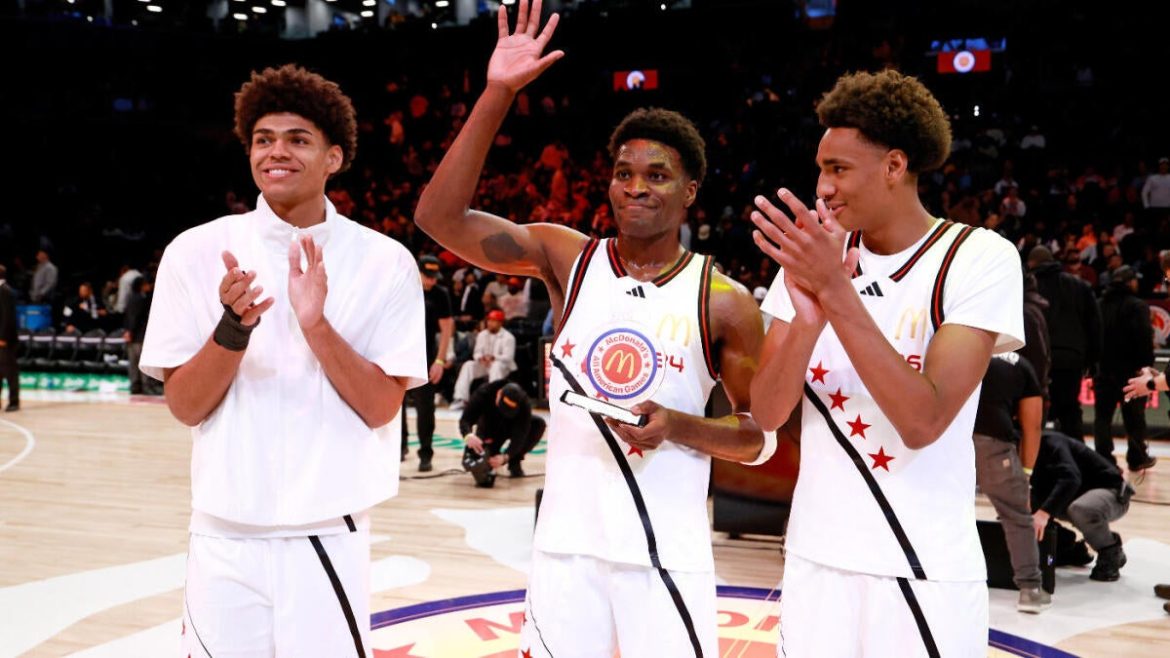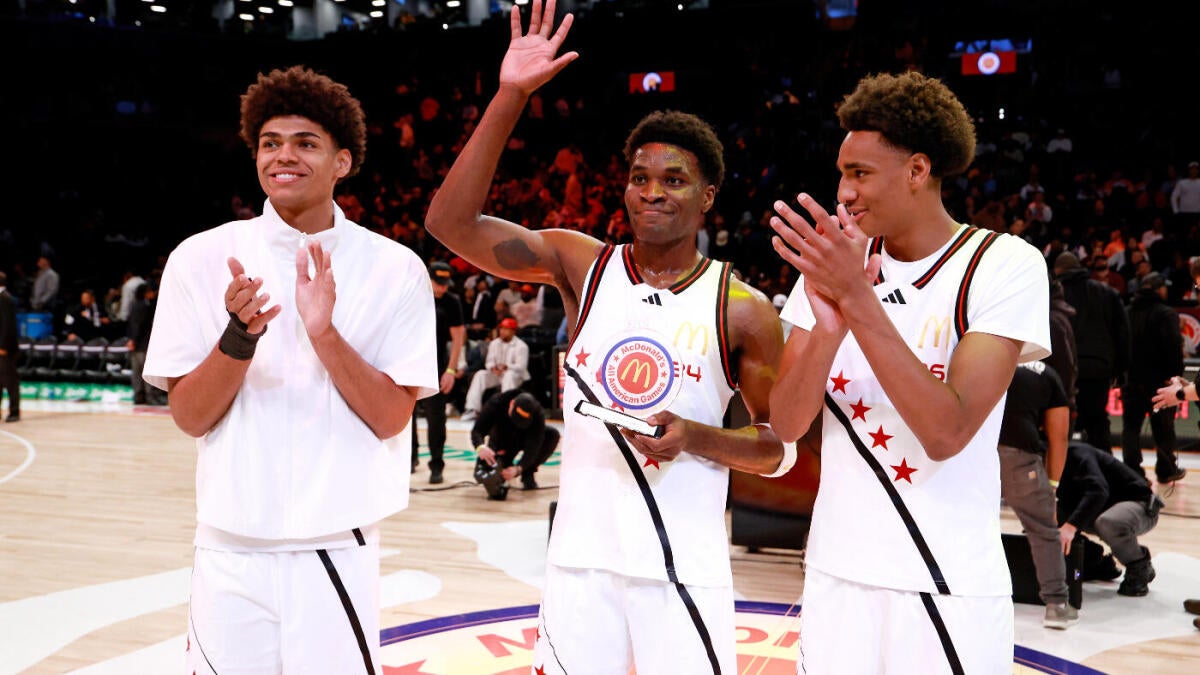The buzz surrounding the 2026 NBA Draft is palpable, and for good reason. This class is shaping up to be one of the most electrifying in years, boasting a prospect pool that combines size, skill, star power, and a healthy dose of drama over the race for the No. 1 pick. At the heart of this draft conversation are three standout players: Kansas’ Darryn Peterson, BYU’s AJ Dybantsa, and Duke’s Cameron Boozer. Their potential is so immense that NBA teams are already strategizing to secure their future lottery odds.
Setting the Stage: A Class Worth Tanking For
The early consensus among NBA scouts and analysts is clear: the 2026 draft is stacked. The preseason “big three” of Peterson, Dybantsa, and Boozer is not just talented but represents a group of players who would likely have been frontrunners for the No. 1 pick in previous drafts. Evaluators are drawing comparisons to historic draft classes like 2003 and 2018, predicting that this group will produce multi-time All-Stars and franchise-changing talents.
This marks a significant shift from recent drafts, where the No. 1 pick was often uncertain until late in the cycle, or where the top prospects came with enough question marks to make teams consider trading down. In 2026, however, teams are openly strategizing for a top-three pick, with some executives even joking—or not—about the virtues of tanking for one of these can’t-miss players. The anticipation is so high that the draft is already being touted as a linchpin moment for teams at every stage of their development, from desperate rebuilders to savvy contenders looking for a transformative piece.
Darryn Peterson: Kansas’ Game-Changing Guard
Darryn Peterson is often at the top of early mock drafts, including ESPN’s, which slots him at No. 1 overall. Standing 6’5” with a robust 195-pound frame and a wingspan built for chaos on defense, Peterson embodies the kind of guard NBA teams crave: explosive, versatile, and impossible to keep out of the paint.
Peterson’s resume is already making waves. He lit up high school circuits with scoring outbursts, including a famous 58-point performance against fellow elite prospect AJ Dybantsa and a 33-point night facing Cameron Boozer. The moment he stepped onto the practice floor at Kansas, buzz erupted inside the program, with teammates marveling at his physical and mental readiness.
Why is he atop so many boards? It’s his blend of NBA-ready size, natural scoring instincts, and the ability to impact both ends of the floor. Peterson isn’t just a “get buckets” guy—he rebounds well for a guard, handles the ball efficiently, and has demonstrated a knack for on-ball defense that should translate immediately to the pros. Add in his playmaking skills and the ability to fill in as a primary or secondary ballhandler, and you have a blueprint for a modern NBA backcourt star.
Some scouts note that Peterson doesn’t carry the same national brand as Dybantsa or Boozer yet, but his high-stakes performances against elite peers and relentless work ethic could push him to consensus No. 1 by draft night. Just ask the Kansas coaching staff: he’s described as “just different”—a compliment reserved for special talents.
AJ Dybantsa: The Swiss Army Wing at BYU
Chasing Peterson—and leading some big boards himself—is BYU’s AJ Dybantsa. At 6’9” and around 200 pounds, he fits the NBA archetype of the monstrously long, athletic wing. What sets Dybantsa apart is his ability to “do it all.” Scouts gush about his two-way potential: he scores at a high clip, can guard multiple positions, stretches the floor, and facilitates for his teammates.
Dybantsa’s game oozes fluidity and impact. He has springs for legs, can finish through contact or over defenders, and has shown more polish as a shooter than many wings his age. BYU, typically off the radar for one-and-done superstars, becomes must-see TV with Dybantsa in the lineup—he’s the rare college player capable of stepping in and dictating both ends of the floor from day one.
With NBA teams forever searching for the next oversized wing to anchor both offense and defense—the Paul George, Jayson Tatum, or Kawhi Leonard types—Dybantsa’s profile is intoxicating. If his perimeter shooting continues to develop and he cuts down on turnovers, he could easily leapfrog to the top slot come draft season.
Cameron Boozer: Duke’s Prototypical Power Forward
Not to be lost in the guard-versus-wing debate, Duke’s Cameron Boozer brings size and skill that teams covet. Standing 6’9” as a freshman with an NBA-ready frame and a game reminiscent of modern stretch fours, Boozer is not just a legacy story (his father Carlos played over a decade in the NBA) but a potential franchise cornerstone.
Boozer’s game stands out for his all-around polish. He scores efficiently from all three levels, rebounds at a high rate, and shows off exceptional feel as a passer and help defender. Duke’s strong track record for producing NBA-ready forwards—think Zion Williamson, Brandon Ingram, Paolo Banchero—only strengthens his case in the eyes of scouts.
Analysts are especially high on Boozer’s motor and leadership qualities. He’s described as “grown-man ready”—the sort of player who could immediately provide value to a rebuilding NBA roster or accelerate a playoff team’s timeline.
The Field: A Deep, Dynamic Lottery
Beyond the headliners, mock drafts project names like Nate Ament (Tennessee), Ace Bailey (Rutgers), and Francis “Kobe” Okeke (G League Ignite) among the lottery’s top-10. This class isn’t just top-heavy; it’s deep, with prospects who would be lottery picks in almost any other year potentially slipping due to the quality at the top.
The result? A first-round that could be loaded with future All-Stars, versatile role players, and enough athletic upside to keep NBA GMs reevaluating their boards up until draft night.
The Early Mock Draft Landscape: Debates and Destinations
Most mock drafts currently oscillate between Peterson and Dybantsa in the top two spots, with Duke’s Boozer a steady presence at No. 3. Some outlets place Dybantsa’s switchable defense and playmaking just ahead of Peterson’s scoring prowess, while others rank Peterson’s off-the-dribble creation a notch higher for NBA value.
Beyond the Big 3, things are fluid: names shift after showcase games, All-American performances, or notable scouting developments. But there’s a clear sense that GMs locked in the lottery will have their choice of multiple franchise-caliber prospects.
Some recent projections include:
– ESPN’s first 2026 mock draft: Peterson No. 1, Dybantsa No. 2, Boozer No. 3
– NBA Draft Room and SBNation: Dybantsa No. 1, Peterson No. 2, Boozer No. 3
– On3: AJ Dybantsa at the top, followed by Peterson and Ament
Remember, draft orders and opinions will swing over the next year as prospects develop, but the Peterson-Dybantsa-Boozer trio already generates a level of anticipation reminiscent of Wembanyama’s year.
Why This Class Matters: The Ripple Effects Across College and the NBA
The 2026 class isn’t just a big deal for NBA teams but for college basketball, NIL deals, and even the G League.
– Impact at College Level: With Peterson, Dybantsa, and Boozer splitting between Kansas, BYU, and Duke, the 2025-26 college season is set for headline matchups, ratings bumps, and ticket demand unseen in years. These programs become national stories, driving up interest among casual basketball fans.
– NIL and Brand Building: Each headline talent arrives in college as a potential marketing magnet; their NIL earning potential rivals what NBA prospects might have seen a decade ago. How they handle the spotlight could affect their draft stock, setting new norms for what off-court value means in player evaluations.
– Ownership Strategies and Tank Wars: Teams mired in the bottom third of NBA standings will be hard pressed not to “punt” seasons for a shot at these prospects. Expect to see loaded trade-deadline sell-offs as clubs clear salary and accumulate picks to maximize their lottery shots.
– Development Pathways: Watch for how international and G League Ignite alternatives impact prospect decisions. While this year’s top names are committed to blue-blood college programs, a deep top 10 means development choices will be scrutinized for every edge.
Conclusion: A Historic Draft Class Poised to Reshape the NBA
This much talent at the top of a draft doesn’t come along often. The 2026 NBA Draft is already a linchpin moment for teams at every stage of their build—from desperate rebuilders to savvy contenders looking for a transformative piece. With Darryn Peterson’s all-around prowess, AJ Dybantsa’s outrageous wing potential, and Cameron Boozer’s ready-made star power, the race for No. 1 will be one of the most fascinating storylines in sports.
But even beyond the top three, the class has the goods to alter the league’s future. Get ready for a yearlong battle between college giants, GMs plotting their great leap forward, and fans glued to the rise of the next NBA faces of the franchise. The 2026 draft hype isn’t just deserved—it’s a preview of the league’s next golden era.





